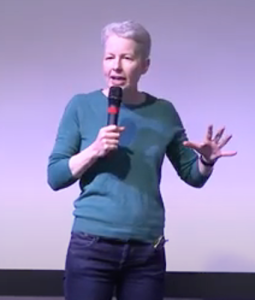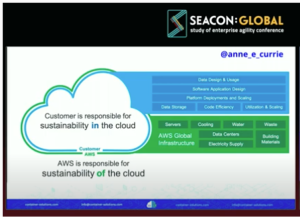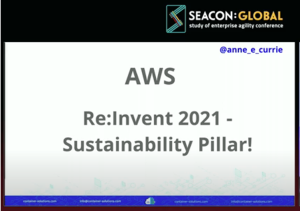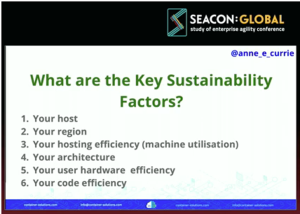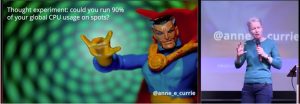-
-
-
-
URL copied!
This year, I attended the SEACON 2022 with Martina Srdoc – Agile Coach at GlobalLogic, as well as other connects from the Agile community.
The conference is like a community of practice on steroids – designed to help participants to ENGAGE, ADAPT and GROW.
Attending events such as these I find are great for sharing knowledge, experiences of enterprise agility and new ways of working – and one of the reasons why I am passionate about communities of practice.
This years’ SEACON had lots packed in – with a vast array of speakers, scheduled workshops, lunch talks, giveaways, signed books, card games and time for networking. A big thank you to the organisers!
While the topics of remote teams, complexity and outcomes came up, I would like to focus the rest of this blog on a talk delivered by Anne Curie called ‘The systems of 2030’ which focused heavily on sustainability.
Anne Currie is an author, Engineer, startup founder and Green Tech Community Leader. She has been in the tech industry for nearly 30 years as an engineer on high performance C servers, is on the leadership team of the Green Software Foundation and the author of Panoptiicon Speculative SF series.
With talks of looking after the climate becoming more and more prevalent, in the next ten years we will see a change in the environment in which our data is stored.
Anne believes that this change will come from the collective effort and power that can only arise from a collective agreement of individuals changing the way in which we operate. We need to push the right buttons within the tech industry – specifically that of the hyper cloud providers as they are the forces that control the weather of the tech industry.
The three main cloud providers are Google, Amazon and Azure. In 2020, they announced that by 2030 they will make their cloud environment carbon zero. Which would mean they provide the rest of us a green infrastructure layer.
Unfortunately, this promise didn’t get off to a good start. Roughly four months after the announcement in the summer of 2021, Google released an Environmental Report – realising, although they are the biggest purchaser of renewal energy, it still wasn’t enough.
Green energy isn’t available all the time when you need it, so they looked into something called ‘time-shifting/demand shifting’. This is a process where some pieces of work are run when the sun is shining or when wind power becomes available. Which meant they worked closely with weather reports, and this has improved over time.
However, Google realised that although they could do this for their own workload, it wouldn’t necessarily work for others, as other organisations work may not be demand-shifting.
So, what are AWS doing about this?
Shortly after Google released their Environmental Report, Amazon released a sustainable blog – stating they were responsible for sustainability of the cloud, meaning the powering and the cooling of it.
In the same blog, Amazon described how we, the users, would be responsible for the systems in the cloud by potentially demand/time shifting for ourselves.
Google strive to be energy efficient and use green power and it’s worth noting that Google have been carbon neutral since 2007.
In the autumn of 2021, AWS hosted its annual Re:Invent conference and announced the introduction of a sustainability pillar. This is included in the AWS Architected Framework, which is based on six pillars.
The AWS Well-Architected Review is an architectural assessment that reviews a specific, business-critical workload against the six pillars – providing quick and targeted analysis to help highlight specific gaps between the current state of cloud environments and AWS best practices. The assessment also provides recommendations on how high-priority issues can be resolved in a timely and cost-effective manner.
See AWS’ whitepaper, discussing their new sustainability pillar – providing design principles, operational guidance, best-practices, potential trade-offs, and improvement plans that can be used to meet sustainability targets for AWS workloads.
During the talk, Anne seemed to allude to the main cloud providers having advance information about the rise in energy prices – so those companies were acting fast and wanted businesses to do the same.
Had businesses responded quickly to the increase in energy prices whilst taking the above sustainability factors into account, companies might have been able to work more efficiently – not to mention the savings on costs!
As Anne rounded up her topic, she left us with a thought to ponder and share with our teams; she called it a thought experiment.
Ask your teams… “could you move 90% of your CPU load to spot instances?”
The idea is to help with moving things around to run when there is green power available. IS this something we can experiment on? Like Anne Currie said, Food for thought!
Concluding thoughts
As someone who was a member of the Green team in a previous organisation, I believe strongly, as Anne has expressed, that to make a change towards sustainability it comes down to individual efforts.
This “it starts with me” attitude has the power to motivate others into action.
When looking at the cloud giants – Google and AWS, each organisation is trying to come up with creative ways to hit their net-zero targets and it’s up to these big companies to drive sustainable efforts, so that other organisations will follow suit. Whether that be by a demand shifting approach or by introducing a new sustainability pillar. Each of these is vital not just to create a green forward-thinking organisation, but to remain competitive in today’s market.
So, I leave you with this thought in addition to Anne’s, what work are you doing in the cloud environment to become carbon zero – both at work and domestically?
About the author
Review by Seun Opanubi
Scrum Master – Delivery Consultant
With my background in Computer System Engineering, I have always worked in technology. I started off with Waterfall methodologies in delivering projects and discovered Agile ways of working about ten years ago. I was quickly exposed to scrum and then other Agile frameworks followed.
Since then, I have been very particular about discovering better practices, which can be fast tracked by joining a community of like-minded individuals in the agile community. I love the saying “we improve collaboratively and evolve experimentally”. Sustainability has been a passion of mine – being lean with waste both at home and in the cloud needs to come as second nature to us all, which takes both time and awareness.
Top Insights
Manchester City Scores Big with GlobalLogic
AI and MLBig Data & AnalyticsCloudDigital TransformationExperience DesignMobilitySecurityMediaTwitter users urged to trigger SARs against energy...
Big Data & AnalyticsDigital TransformationInnovationRetail After COVID-19: How Innovation is Powering the...
Digital TransformationInsightsConsumer and RetailTop Insights Categories

Let’s Work Together
Related Content
Intelligence is Intelligence, even if it’s Artificial
I had a stimulating conversation with the head of our GenAI practice, Suhail Khaki, a few weeks ago. Suhail made the remark that the more he works with GenAI, the more it strikes him that it’s less like conventional computer software, and more like a person in the way it interacts. He made the remark: … Continue reading SEACON 2022: sustainability overview →
Learn More
We’re getting the chance to live in the future
Early 20th Century motivational speaker and author Dale Carnegie once wrote “Today is the tomorrow you worried about yesterday.” I believe that Mr. Carnegie’s point was that unless today is the literally the worst day of your life (and my sincere sympathies if it is), then the energy you spent worrying about it yesterday was largely wasted. I haven’t read much … Continue reading SEACON 2022: sustainability overview →
Learn More
Share this page:
-
-
-
-
URL copied!
